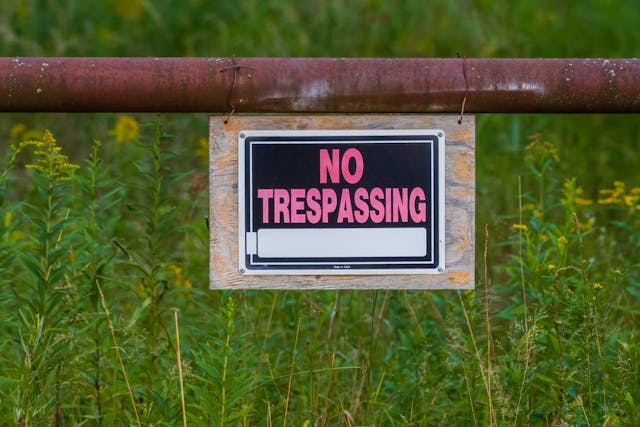How to Set Healthy Boundaries
Any relationship without healthy boundaries can lead to uncomfortable situations. If people make us uncomfortable, or an employer tries to make us work overtime, or friends borrow our things without asking, this causes tension or frustration. Over time, it could even ruin a relationship.
So, for your own peace of mind and general well-being, and space in a relationship, it’s important to understand what makes healthy boundaries, as well as how to establish them.
These boundaries are not supposed to be like walls that cut us off from interacting with people. They are more like fences, with windows and gates, that allow others to know your expectations, beliefs, and levels of comfort in various things.
Effective boundaries assist in all types of interactions and involve clear communication.
So if you feel overwhelmed, frustrated, bitter, or even violated by some of the people in your life, chances are that it’s time to examine your personal boundaries. Doing so can “save you stress and give you a sense of control and freedom” in your relationship.1
On this page, we’ll cover the following topics to give you tips on how to set healthy boundaries:
- What are boundaries?
- What healthy boundaries look like
- Healthy boundaries in different kinds of relationships
- Why setting healthy boundaries is important
- How to set and maintain healthy boundaries
- The value of healthy boundaries
Let’s start with the right definitions.
What are Boundaries?
In human relations, boundaries are guidelines that clearly communicate what acceptable behaviour you expect from other people, or what others expect from you.
In other words, they are like lines or borders that help people understand how you want others to treat you, and what you can offer in any relationship.
But what exactly do healthy relationships look like?
What Healthy Boundaries Look Like

Photo by Edz Norton on Unsplash
Healthy boundaries are those limits or restrictions we set in relationships to protect the quality of our lives by promoting safety, a sense of comfort, and mutual respect.
They guard our time, space, personal matters, feelings, etc.
Let’s look at a few of them and some practical examples.
Physical Boundaries
Physical boundaries can involve establishing rules about:
Healthy physical boundaries may look like:
- Telling someone you’d rather shake hands than hug
- Telling people not to smoke in your house
- Restricting people from entering your bedroom
- Limiting people from entering your office when you are not present
Emotional Boundaries
Emotional boundaries are limits that protect the following:
- Your right to own your feelings
- Your right to express thoughts without fear of being judged or ridiculed
- Your right to be heard, and the expectation that the other person will try to understand as best as possible
- Your right to live by your values
Healthy emotional boundaries may look like this:
- Saying no to discussing topics you are not comfortable with
- Not taking it upon yourself to try to moderate or control the feelings of others, but instead letting others take responsibility for their own feelings and reactions
- Choosing not to let other people’s feelings have too much influence on your actions
- Accepting that we may not meet other people’s expectations all the time
Also, emotional boundaries define how much energy and mental effort you are willing to give or receive from others. For example, if your friend’s or partner’s anger makes you exhausted, scared, or frustrated, think of what you will need to do in order to prevent their emotions from causing you unnecessary or unproductive stress.
Financial or Material Boundaries

Photo by cottonbro studio on Pexels
Material or financial boundaries revolve around things we possess such as:
- Money
- Vehicles
- Electronic devices
- Houses, etc.
Some charitable people may find it hard to say no when people ask for their money or possessions. But having healthy material boundaries can help you reach a compromise that will protect you and the people in your relationship.
An example of how to create a financial boundary would be to set up a budget that prioritises the essentials and leaves a set amount for discretionary spending—including charitable giving. Or it could be taking time to determine ahead of time how much money per month you’d be fine with lending to friends or family. It could also be developing a protocol for lending and repaying money, and making sure your friends and family understand this before asking you for anything.
Sexual Intimacy Boundaries
Sexual boundaries define interactions in a sexual relationship.
These include:
- How frequently you want to have sexual intimacy
- The types of sexual contact you feel comfortable with
- Your choice of contraceptives
An example of a sexual boundary is where partners agree to seek each other’s consent or communicate their intentions before sexual intimacy.
And this is a good time for a reminder that healthy sexual intimacy is about meeting each other’s needs, not only thinking about our own.
Communication Boundaries

Photo by Diva Plavalaguna on Pexels
Communication boundaries involve setting limits and expectations on how individuals in a relationship relate to each other. For example, a husband and wife can agree to avoid digging up past quarrels when they are upset.
These boundaries may also involve:
- Not interrupting each other when talking
- Giving each other their full attention when they’re being spoken to
- Choosing to avoid unhelpful habits in arguments, such as name-calling, nit-picking, shouting, etc.
Time Boundaries
Time boundaries regulate how we manage our time, which is a limited resource! These boundaries enable us to allocate enough time for the most important parts of our lives, such as relationships, work, hobbies, etc. In other words, they allow you to prioritise your time for things you value most.
These limits can help you to have clear expectations so that you don’t overcommit or undercommit.
Time boundaries may look like:
- Setting aside planned time for reading
- Staying off social media for a certain amount of time each day
- Spending 45 minutes with a friend after work every Thursday
Now with that in mind, let us consider healthy boundaries in various kinds of relationships.
Healthy Boundaries in Different Types of Relationships
Every relationship, whether family, work, or romantic, should have clearly defined guidelines. And every relationship is different, which may call for different boundaries.
Let’s start with Romantic relationships.
Healthy Boundaries in Romantic Relationships

Photo by Wo Nfoni Media on Pexels
Boundaries under this category define what romantic or sexual partners are comfortable with. They are formulated with three things in mind: you, your partner and the romantic relationship you are in.
What defines these boundaries the most is the many areas they will need to cover. Since you share your lives together, your boundaries are not just your own, but they will have to be discussed and negotiated with each other.
These boundaries should be aimed at ensuring that each romantic partner has the space and comfort they need, and that the relationship is continually nourished. It also must include the limits you will jointly set on things you share, such as:
- Communication
- Finance/budgeting
- How much time you want to spend together
- Household duties
Healthy Boundaries at Work
Having healthy boundaries at work can prevent burnout and uncomfortable situations. This is because workplaces can sometimes be toxic environments depending on the relationship between you and your supervisors, or because of the unethical behaviour of workmates.
Let’s look at an example.
Imagine a situation where your manager always wants you to work overtime, including the weekends. If you never say no or talk to your manager about this, it can start affecting your health and denying you time for family and other personal necessities.
To set a professional boundary isn’t always easy, but you may want to start with asking to meet with your manager and discuss what you are willing to do, and what you are not. Then your manager will at least be aware of your boundaries, and this will help in figuring out negotiations.
Healthy Boundaries in the Family
Healthy family boundaries are guidelines that define how family members relate to each other.
These can include:
- Not gossiping about anyone to avoid conflict and feelings of resentment2
- Rules for a curfew for your children
- Boundaries about when you have time to visit relatives
- Choice of parenting styles
- Conflict resolution mechanism
- Household responsibilities
- Privacy
- Travel and leisure3
Also, they can cover religious beliefs, political ideologies, cultural rites, entertainment, education, etc.
For example, if you’re sharing a room with your siblings and you need alone time to read something. But, they spend the evening shouting, playing, and watching television. You can discuss with your family and share how that makes you uncomfortable so that you reach a compromise that benefits all. This could be something like setting rules or defining specific times and places in the house for study, entertainment, solitude, etc.
Having to do this, especially with close family members, may feel strange or uncomfortable at first. But once these boundaries are understood, they even strengthen the family bond and bring about mutual respect between you and others.
Healthy Boundaries with Friends

Photo by Paul Ndayambaje on Pexels
These are boundaries that describe the limits within your relationship with your friends.
They can define:
- How you share personal information
- How much time you want to spend with them
- What your relationship entail, or what your expectations are from them
For example, a boundary with friends may lead you to decide to go home early and do something else when your friends are spending their night at a party, or going to a place you don’t want to go to.
But it could also be as simple as letting a friend know certain subjects of conversation that you generally won’t engage in, such as talking negatively about others, or about certain political, religious, or cultural topics.
One challenge that sometimes emerges when setting healthy friendship boundaries is the fear of losing friends. But this shouldn’t stop you from setting boundaries because any true friend who values your safety, health, and happiness will be glad to know your boundaries and respect them.
Healthy Boundaries with Strangers
Setting healthy boundaries when dealing with people you don’t know can prevent uncomfortable situations.
A healthy boundary with strangers may involve the following:
- Not giving or accepting rides from strangers when you are alone
- Maintaining a safe distance or personal space when around strangers
- Being mindful of what information you share with them
- Not permitting any strangers to touch you, etc.
Now let’s delve into the importance of setting healthy boundaries.
Why Setting Healthy Boundaries is Important
Setting healthy boundaries aims to promote your physical, intellectual, and emotional well-being. They maintain good relationships and prevent toxic ones.
Here is why:
- Healthy boundaries create trust because even those who may not like your ideas can respect you for taking a stand for what you believe in.4 Thus, this can build healthy relationships5
- They improve productivity and prevent burnout through overwork, or overcommitment
- They can promote a sense of safety
- They prevent manipulation or being taken advantage of
- They promote and help you maintain individuality by enabling you to express your own feelings and thoughts.6 This also reinforces empowerment and respect.
- Healthy boundaries can also prevent conflicts by outlining the expectations and responsibilities of each party and ensuring clear communication. This in turn promotes closeness.
- They also enhance your mental health by reducing stress, protecting you from toxic relationships, and improving your self-esteem
The benefits of setting healthy guidelines can be endless. But, we should also be aware of unhealthy boundaries.
Let’s unmask them.
Unhealthy Boundaries
As the name suggests, unhealthy boundaries are edges that can be too loose or too rigid. They can involve having no boundaries, or boundaries that aim at manipulating or controlling another.

Photo by RDNE Stock project on Pexels
Having no boundaries can make good relationships prey to conflicts that could have been avoided. They could also perpetuate toxic relationships that are fueled by resentment.
On the other hand, too rigid boundaries can lead to people closing themselves off from others. They could also be so rigid that they don’t allow for other people’s boundaries to be respected as well, which can lead to attempts of manipulation or controlling other people.
Here are examples of unhealthy boundaries:
- Accepting things you don’t want, or never allowing yourself to say no, because you want to please a friend
- Permitting other people to talk disrespectfully to you, or to make fun of you without your consent
- Engaging in activities you normally don’t approve of for the sake of impressing others
To find a solution to these challenges, it is important to establish why they happen in the first place.
Reasons Why Boundaries Aren’t Established and Asserted
Unhealthy boundaries can emerge due to a lack of experience in setting boundaries. And sometimes, they surface because we disregard our “own and others’ values, wants, needs, and limits.”⁷
For example, let’s say you are in a relationship with a friend who likes sharing pictures online and you don’t. But you haven’t told them. Then one day they flood their social media with your pictures. A few days later you find out and make it known that you don’t like your pictures posted online. If your friend does it again, then it is a disregard of your boundaries.
Other reasons we might neglect to assert our boundaries include:
- Fear of rejection such as someone walking out of your life because of your boundaries
- Low self-esteem or being a people pleaser
- A desire to manipulate or control others
- Having naive, shallow, or unrealistic expectations of others
And sometimes culture can also be a stumbling block. Therefore cultural context should be considered.
Let’s find out why.
Cultural Challenges in Setting Healthy Boundaries
Boundary settings in some communal cultures like in Africa and Asia can be very daunting.
Have you ever wondered why?
Because many communities are closely knit. They do various things together and depend on each other. Their decision-making process is majorly a collective responsibility. And some of their core values are loyalty to culture, sacrifice to serve the community, and honour for the elders.8
These may bring tensions when setting boundaries because anything that tends to draw a line of separation between families or friends can appear strange or alienating.
For example, if you visit a family and they invite you to eat with them, saying no or setting a limit without explaining yourself could be perceived as selfish or rude.
In such cultures, it can be practical to apply workable boundaries. These are flexible boundaries that consider the culture and the values of a community.9
It can also involve a compromise in drawing boundaries that will consider cultural expectations but still protect you and the relationship.
Because this can be a complex situation. Draw your boundaries with others in mind, considering their feelings and perceptions as well. But don’t let the fear of affecting others stop you from setting boundaries altogether.
Here are some dangers to be aware of when you don’t set boundaries.
Dangers of Not Setting Healthy Boundaries
A lack of healthy boundaries can lead to failure in achieving your goals, watering down your values, and a lack of self-respect.
And in many situations, it can worsen:
- Physical suffering due to overwork, abuse, etc.
- Toxic or damaged relationships due to misunderstood expectations, manipulation or lack of support.
- Bitterness because of frustration or grudges
- Overwhelming stress due to financial misuse or lack of trust
- Being taken advantage of by other parties
Now that we know the risks of not setting boundaries, let’s find out how to set and maintain healthy boundaries.
How to Set and Maintain Healthy Boundaries
Setting healthy boundaries begins with self-awareness, introspection, and consideration for both others and yourself.
Here are some steps you can take when setting any relationship boundaries:
Analyze What Makes You Uncomfortable

Photo by Darina Belonogova on Pexels
Think of times when situations involving relationships made you feel uncomfortable or disrespected. What are your current needs to fix that? And how have your past circumstances impacted your life?10
Then, guided by your values and core beliefs, write down what you want to see in those relationships.
That might include:
- What makes you feel fulfilled or things that matter to you
- How you would like to be treated and how you would treat others
- How much time, money, or energy you are willing to devote to the relationship
- Things that would make you productive, happy, and secure
After you have come up with what you want in your relationship, then you are ready for the next step.
Know What You Want
Now go through the boundaries you have jotted and scrutinise them one by one. At this stage, you can think through the practicality of each boundary, and how to apply it.
This is also the stage where you review your life and see what mistakes you can learn from. For example, you can reflect on what has made you uncomfortable in the past or the times when you allowed others to invade your personal space.
Then comparing your past experiences with your new boundaries, see if your new guidelines can prevent such experiences from reccurring.
Once you are done analysing your own boundaries, you can now own them.
Believe That It’s Okay to Ask for Space
Believe that just like any human being, you deserve respect and have the right to formulate and enforce your boundaries.
And yes, sometimes after we set boundaries, we may feel guilty. Especially in African cultures where we embrace a cultural duty to neglect boundaries in favour of serving the community. But despite the guilt, remorse or a sense of selfishness, we all deserve to be treated kindly and loved.
So to believe in having healthy boundaries can set that stage for your self-care.
Consider Other People’s Needs and Boundaries

Photo by Aaron J Hill on Pexels
People we have relationships with also have boundaries. Being mindful of their needs can ensure that we’re not making unreasonable or selfish demands but asking for things that will better our relationship and our own peace of mind.
So after we evaluate the other person’s boundaries, we can adjust our boundaries to accommodate their needs. However, this modification should happen within our principles and values.
And now that we have our boundaries formed, when is the best time to share them?
Consider the Right Timing
It is advisable to share or set healthy boundaries early in any relationship. But if they are formulated later in the relationship, then you can do it as soon as you see the need.
Once you have that prime opportunity, communicate your limits.
Communicate Your Boundaries
Being able to clearly communicate your boundaries is crucial for healthy relationships. When we voice our needs, we give each other a chance to understand what our boundaries are, and why we value them.
Also, communication offers a stage for openness and honesty between partners. It makes it easy to talk about even those difficult personal issues that are sometimes challenging to discuss.
Here are some key communication principles we can keep in mind:
- Be clear, specific, and straightforward
- Give room for discussion to clarify vague points and to get feedback
- Keep calm and composed without raising your voice
- If you are nervous and think you might forget your points, write them down
A general communication tip in such a conversation is to use “I” statements instead of “you” statements. This is because using “you” statements can make the other person feel criticised, attacked, accused, or rejected.
For example, let’s say you don’t like interruptions when doing something important. Instead of saying “I don’t like it when you interrupt me during my work hours,” you can say “I feel very disoriented when I am interrupted in my work.”
That shifts the focus to you and how you feel rather than their behaviour.
Once we are done communicating our boundaries, we are to remember that it doesn’t stop there.
We need to apply them.
Enforce Boundaries
Healthy boundaries that are not enforced are not worth formulating because they won’t serve their purpose. But when you enforce them, you not only earn self-respect but also get peace of mind.
So, how do we practically enforce healthy boundaries?
Here are some suggestions:
- Have clear and reasonable consequences for crossing boundaries. For example, a parent may have a curfew in their home that children should be home by dinner time. A consequence of not doing this can be missing a family tour.
- If boundaries are crossed, give a clear reminder. This should be the case whether the boundaries were crossed intentionally or unintentionally.
- Learn to say no to things you aren’t comfortable with. This might be difficult when dealing with those dear to us, but it’s vital in maintaining relationships.
In short, boundaries need to be firmly established, but not without “room for some negotiation and grace if someone doesn’t fulfil their end of the bargain.” This includes giving someone a chance to correct their course of action unless it’s a life-threatening situation.11
So setting and enforcing healthy boundaries in any relationship should be encouraged because it is invaluable.
The Value of Healthy Boundaries
Clearly set and enforced boundaries can benefit both the one who sets them and the person on the receiving end.12 And when you understand each other’s boundaries, you can enjoy a strong balanced healthy relationship.
And this is always a work in progress. It requires continuous adjustments depending on how you grow in your relationship and the challenges that arise.
Having clear relationship guidelines will be a game changer for anyone. For example, a people pleaser who fears confrontation can learn to say no to excessive demands. And someone in a codependent relationship who struggles to separate their feelings from others can find their niche.
By avoiding extremes in relationships we can communicate our needs and expectations clearly and calmly with other people.
On one hand, we’ll not be unreasonable, controlling, and unmindful of other people’s boundaries. And on the other hand, we can avoid being too lenient to the point of being vulnerable to exploitation. That way, we can create practical, value-based, and healthy boundaries.
So, here is a challenge to try. Think about your relationships and come up with practical guidelines in those areas that make you uncomfortable, stressed, or unproductive. Once you are done, share them with those involved.
- Bhandari, Smitha, MD, Setting Boundaries, WebMD, February 25th, 2024. https://www.webmd.com/mental-health/setting-boundaries [↵]
- 10 Ways To Set Boundaries With Difficult Family Members, Taylor Counseling Group, March 03, 2022
https://taylorcounselinggroup.com/blog/set-boundaries-for-difficult-family-members/ [↵] - Kessler, Owen, 26 Examples of Healthy Boundaries in a Relationship, Marriage.com, November 28, 2023. https://www.marriage.com/advice/marriage-fitness/examples-of-healthy-boundaries-in-relationship/#:~:text=Examples%20of%20healthy%20boundaries%20in%20a%20relationship%20can%20include%20physical,one’s%20own%20beliefs%20and%20thoughts). [↵]
- Andrade, Sahar, MB.BCh, The Importance Of Setting Healthy Boundaries, Forbes, December 10, 2021 https://www.forbes.com/sites/forbescoachescouncil/2021/07/01/the-importance-of-setting-healthy-boundaries/ [↵]
- Ibid. [↵]
- Ibid. [↵]
- Beeslaar, Eleanor, Healthy vs. Unhealthy Boundaries, Healthy Relationships Initiative. https://healthyrelationshipsinitiative.org/healthy-vs-unhealthy-boundaries/ [↵]
- Brady, Shabnam, The sensitivity of boundary setting in collectivist cultures, American Counseling Association, October 2021, https://www.counseling.org/publications/counseling-today-magazine/article-archive/article/legacy/the-sensitivity-of-boundary-setting-in-collectivist-cultures [↵]
- Ibid. [↵]
- How is Life Tree(ting) You?: Trust, Safety, and Respect – The Importance of Boundaries, Stanford University, https://studentaffairs.stanford.edu/how-life-treeting-you-importance-of-boundaries [↵]
- Haupt, Angels, How to Set Boundaries With Relatives, According to Family Therapists. Time https://time.com/6331383/how-to-set-boundaries-family/ [↵]
- Ibid. [↵]
Ask Your Own
Question

Have a question that hasn’t been answered yet?
We’d love to hear from you! Send us a message with your question:
Join the discussion
Comment your own thoughts to start the conversation!
Discussions are moderated. Please read our Comment Policy.

